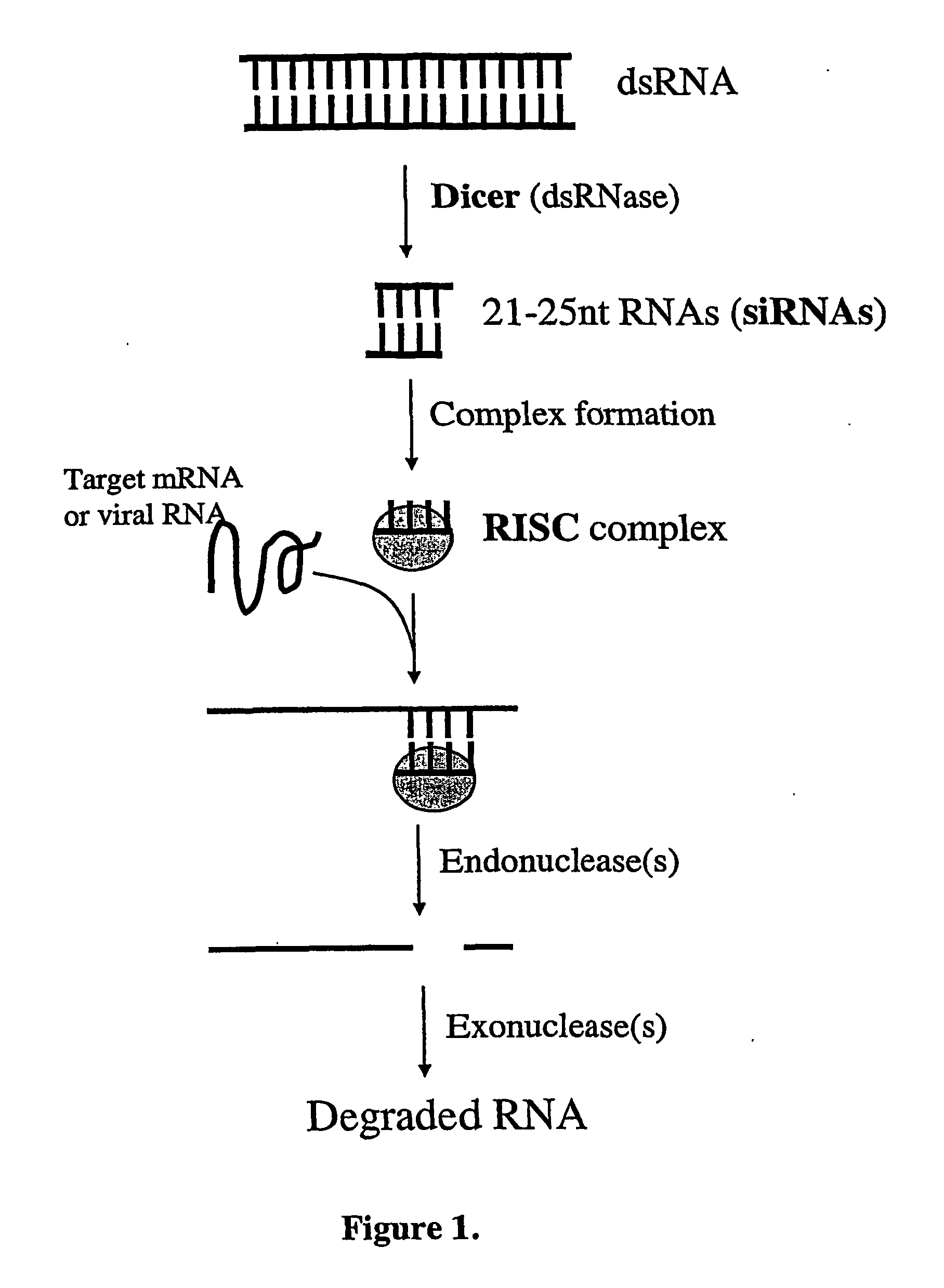Modified Gene-Silencing Nucleic Acid Molecules and Uses Thereof
a nucleic acid molecule and gene-silencing technology, applied in the field of modified genesilencing nucleic acid molecules, can solve the problems of hammering the intact maintenance of these nucleic acids, application of this method for downregulating target genes, and document does not teach the use of target genes involved in animal disease or animal function
- Summary
- Abstract
- Description
- Claims
- Application Information
AI Technical Summary
Benefits of technology
Problems solved by technology
Method used
Image
Examples
example 1
Construction of Different Chimeric Genes for Mediating Gene Silencing of a GFP Gene in Mammalian Cells and Analysis in CHO Cells
[0298]A gene encoding green fluorescent protein (GFP) with a “humanised” coding region was chosen as an example target gene for down-regulation of expression in mammalian cells. The construct pCi-GFP was obtained from Fiona Cameron of CSIRO Molecular Science. The GFP coding region was excised from pCi-GFP with NofI / NheI, blunted with Pfu polymerase to fill in the single-stranded ends, and inserted into the NheI site of the pCi vector after treatment with Pfu polymerase. The resultant plasmids were pMBW449; (also designated “asGFP”) which has the GFP coding region in an antisense orientation with respect to the CMV promoter of pCi, and the plasmid pMBW450 (also designated “senseGFP” or “sGFP”) which has the GFP coding region in the sense orientation with respect to the promoter. Both constructs have an SV40 nucleotide sequence comprising a polyadenylation si...
example 2
Use of Chimeric Nucleic Acid Molecules for Mediating Gene Silencing of a GFP Gene in Mammalian Cells-Cancer Cells
[0304]To compare the efficiency of gene silencing of the modified antisense to a hairpin RNA (RNAi) construct, we constructed pLMW90 as follows. A Fiaveria pdk intron sequence obtained from pHannibal was excised with EcoRI / XbaI and inserted into the EcoRI / XbaI site of pMBW449, giving pLMW90. This plasmid already contained an antisense GFP sequence. A second GFP sequence was inserted, orientated in a sense direction with respect to the promoter, by inserting a GFP fragment excised with NheI / SmaI and treated with Pfu polymerase to blunt the fragment, into the SmaI site of pLMW90, forming the hairpin RNA construct pLMW92 which contained an inverted repeat (antisense / sense) of the GFP sequence separated by the pdk intron, and pLMW93 which contained a direct repeat of the antisense GFP sequence (antisense / antisense). These constructs are shown schematically in FIG. 7.
Transfect...
example 3
Assessment of Gene Silencing in Animal Cells
[0311]To determine whether gene silencing could be enhanced in a range of animal cells by the use of the modified nucleic acid molecules, experiments were carried out to silence a reporter gene (EGFP) in a variety of animal cell types using the gene silencing constructs shown schematically in FIG. 18. A further construct was made for comparison with the others, in order to test a region from an snRNA as a nuclear localisation signal. Small nuclear RNA (snRNA) molecules are known to be nuclear localised and to include largely double stranded regions. An example of an snRNA is the U6 RNA molecule. The sequence of the human U6 RNA is shown in FIG. 16, and shown schematically as a folded structure in FIG. 17 (lowest predicted free energy).
[0312]The PSTVd sequence on pMBW491 was replaced with a sequence from the human U6 snRNA. The human U6 snRNA was amplified by PCR from genomic DNA isolated from cultured HeLa cells, using:
forward primer (U6Mu...
PUM
| Property | Measurement | Unit |
|---|---|---|
| pH | aaaaa | aaaaa |
| length | aaaaa | aaaaa |
| secondary structures | aaaaa | aaaaa |
Abstract
Description
Claims
Application Information
 Login to View More
Login to View More - R&D
- Intellectual Property
- Life Sciences
- Materials
- Tech Scout
- Unparalleled Data Quality
- Higher Quality Content
- 60% Fewer Hallucinations
Browse by: Latest US Patents, China's latest patents, Technical Efficacy Thesaurus, Application Domain, Technology Topic, Popular Technical Reports.
© 2025 PatSnap. All rights reserved.Legal|Privacy policy|Modern Slavery Act Transparency Statement|Sitemap|About US| Contact US: help@patsnap.com



